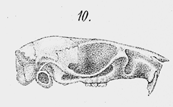Akodon is a genus consisting of South American grass mice. They mostly occur south of the Amazon Basin and along the Andes north to Venezuela, but are absent from much of the basin itself, the far south of the continent, and the lowlands west of the Andes. Akodon is one of the most species-rich genera of Neotropical rodents. Species of Akodon are known to inhabit a variety of habitats from tropical and tropical moist forests to altiplano and desert. Fossils are known from the late Pliocene onwards.
The Paraná grass mouse is a South American rodent species of the family Cricetidae. It is found in northeastern Argentina and southeastern Brazil.

Oligoryzomys flavescens, also known as the flavescent colilargo or yellow pygmy rice rat is a species of rodent in the genus Oligoryzomys of family Cricetidae. It is found in southern South America, occurring in southern Brazil, Paraguay, Uruguay, and northeastern Argentina. Its karyotype has 2n = 64-66 and FNa = 66-70.
Akodon albiventer, also known as the white-bellied grass mouse or white-bellied akodont, is a species of rodent in the family Cricetidae. It is found in the Andean highlands from southeastern Peru to southwestern Bolivia, northwestern Argentina, and far northeastern Chile at elevations from 2400 m to over 5000 m.
The Bogotá grass mouse or Bogotá akodont, is a species of rodent in the family Cricetidae. It is found in the Andes eastern and central Colombia and northwestern Venezuela. Alavarado-Serrano and D'Elía (2013) have assigned the species to a new genus, Neomicroxus along with Neomicroxus latebricola.
Akodon boliviensis, also known as the Bolivian grass mouse or Bolivian akodont, is a species of rodent in the family Cricetidae. It is found in the Andes from southeastern Peru through Bolivia into northwestern Argentina.
Akodon budini, also known as Budin's akodont or Budin's grass mouse, is a species of rodent in the family Cricetidae. It is found in the Andes of northwestern Argentina and adjacent Bolivia. The species is named after Emilio Budin, an Argentine specimen collector who worked with Oldfield Thomas.
The smoky grass mouse is a species of rodent in the family Cricetidae. It is found in Argentina, Bolivia and Peru.
The intelligent grass mouse or Patagonian akodont is a species of rodent in the family Cricetidae. It is found in Argentina and Chile.
Abrothrix lanosus, also known as the woolly grass mouse or woolly akodont, is a species of rodent in the family Cricetidae. It is found in southern Argentina and Chile. It was previously classified in the genus Akodon rather than Abrothrix.
The Altiplano grass mouse is a species of rodent in the family Cricetidae. It is found in Bolivia, and Peru.
The white-throated or grey-bellied grass mouse is a species of rodent in the family Cricetidae. It is found in Argentina and Bolivia.

Akodon spegazzinii, also known as Spegazzini's akodont or Spegazzini's grass mouse, is a rodent in the genus Akodon found in northwestern Argentina. It occurs in grassland and forest at 400 to 3,500 m above sea level. After the species was first named in 1897, several other names were given to various populations now included in A. spegazzinii. They are now all recognized as part of a single, widespread and variable species. Akodon spegazzinii is related to Akodon boliviensis and other members of the A. boliviensis species group. It reproduces year-round. Because it is widely distributed and common, Akodon spegazzinii is listed as "least concern" on the IUCN Red List.
The Chaco grass mouse is a species of rodent in the family Cricetidae. It is found in Argentina, Bolivia, and Paraguay.
The Andean mouse is a species of rodent in the family Cricetidae. It is the only species in the genus Andinomys. It is found in Argentina, Bolivia, Chile, and Peru.
The Andean vesper mouse is a species of rodent in the family Cricetidae. It is found in Argentina, Bolivia, Chile, and Peru.
Euryoryzomys legatus, also known as the Tarija oryzomys or big-headed rice rat, is a species of rodent in the family Cricetidae. It now belongs to the genus Euryoryzomys, having previously been placed in Oryzomys. It is found in the eastern Andes of northwestern Argentina and southern Bolivia.

Akodon caenosus is a rodent in the genus Akodon found in northwestern Argentina and south-central Bolivia. Since its description in 1918, it has been alternatively classified as a separate species or a subspecies of Akodon lutescens. The species Akodon aliquantulus, described from some very small Argentine specimens in 1999, is now recognized as a synonym of A. caenosus.
The Córdoba vesper mouse or Córdoba laucha is a South American rodent species of the family Cricetidae. It is endemic to the area of Córdoba Province, central Argentina, where it is found in the espinal.

Abrotrichini, also known as the Andean clade or southern Andean clade, is a tribe of rodents in the subfamily Sigmodontinae. It includes about fifteen species in four genera, distributed in South America from southern Peru to southernmost South America, including the Patagonian steppes. The earliest known fossils are from the Pliocene of Argentina.





